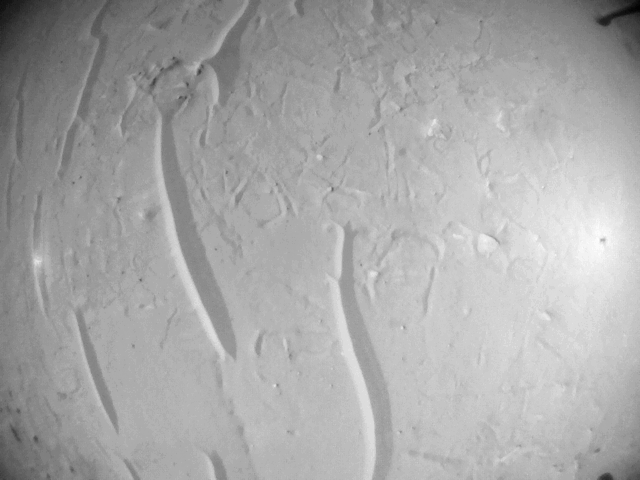50 flights on Mars! Ingenuity helicopter's record-setting hop is a giant leap for exploration
Ingenuity flew higher than ever before on Mars flight number 50, which occurred on Thursday (April 13).

NASA's incredible Mars helicopter has now flown 50 times on the Red Planet.
Originally rated for just five Martian sorties, Ingenuity notched its 50th on Thursday (April 13), acing a 146-second flight that took it 59 feet (18 meters) above the Red Planet's surface — higher than it's ever gone before.
The 4-pound (1.8 kilograms) drone continues its epic journey on Mars, serving as a scout for NASA's Perseverance rover mission and testing key tech that could help return samples from the Red Planet in the coming years as part of the ongoing search for life on Mars.
"She has blown out of the water any sort of metric of success," Theodore Tzanetos, Ingenuity team lead at NASA's Jet Propulsion Laboratory (JPL) in Southern California, told Space.com last month.
"It's not just a statement of our reliability design, but it's also a statement about the technicians that can assemble this thing, right?" he said. Tzanetos added that the Ingenuity team "has really done miraculous work" that will help in getting two sample return helicopters flying on Mars a few short years from now.
Related: Liftoff on Mars! Perseverance rover captures amazing video of Ingenuity helicopter flight
No rotorcraft had flown on a world beyond Earth before Ingenuity made its first tentative hop on April 19, 2021, just two months after it landed on the floor of Mars' Jezero Crater aboard Perseverance.
Get the Space.com Newsletter
Breaking space news, the latest updates on rocket launches, skywatching events and more!
Ingenuity hovered 10 feet (3 m) off the ground during a 40-second flight, a milestone hailed by then-NASA science chief Thomas Zurbuchen as "a true extraterrestrial Wright Brothers moment."
Getting Ingenuity off the ground was a milestone in itself, as the Martian atmosphere is quite thin and nobody can directly stick-shift the helicopter from Earth; the time delay between communications and receipt is too long for real-time control. But the flight plan uploaded to Ingenuity went well, and other flights ensued.
"The primary goal is still alive: to be a technology demonstrator," Tzanetos said. But the drone is also now serving as a scout for Perseverance, as the duo explore an ancient river delta on the floor of Mars' Jezero Crater. Moreover, the focus is shifting to refining operations, teamwork and design decisions as NASA works to develop two Martian helicopters for its Red Planet sample-return effort.
The dual drones on the sample return mission, which is slated to launch in 2028, will serve as backups for Perseverance if the rover cannot ferry the samples it's currently collecting to a rocket-toting lander on its own; the rover has cached some sample tubes in a "depot" on Jezero's floor, which the little Ingenuity-like choppers could fetch and return to their mothership lander.
Related: NASA's Mars Perseverance rover sample tubes look like Star Wars lightsabers

To help mission planners get ready for the sample-return effort and other future rotorcraft missions, Ingenuity continues to carefully push its limits. A new "mitigation capability" added in a recent software update allows the drone to pick its own landing zone if it deems the default area too rocky or otherwise dangerous. Its navigation system was also upgraded to include digital elevation maps to account for the hills it must navigate, miles away from its original flight paths.
Meanwhile, the team is keeping track of how Ingenuity flies in the Martian atmosphere, the amount of dust slowly building up on its solar panels, the heat and cold flexing its metal, and other key parameters to make the next generation of copters all the stronger. When the two new choppers, nicknamed SRH (sample return helicopters), arrive, they'll include new features as well, like a pinpoint landing system that allows them to pick up cached sample tubes.

Ingenuity's unexpectedly long lifespan has had ripple effects on the mission team, which at first was working to a "30-day sprint" on a limited flight plan, Tzanetos said. JPL engineers often work on multiple projects; after the five-flight primary mission ended, some elected to stay with the Ingenuity team, while others dropped to partial time or moved fully on to other things.
"I believe the team morale is great, especially now that we've grown significantly from that original technical team," Tzanetos said, noting that JPL makes sure its team members can take vacations and holidays. (Something on the order of a dozen full-time equivalent positions support Ingenuity, although those numbers are spread among more people given that not everyone is full-time on the project.)
It's hard to predict how long Ingenuity will continue to fly, although it remains in excellent health. The only potentially life-limiting consumables are leg dampers designed to soften each landing, but the loss of those "won't necessarily spell the end," as flight paths can be adapted to achieve soft touchdowns, Tzanetos said.
Ingenuity's lithium-ion batteries remain within about five millivolts of where they need to be, the solar panels remain relatively clear of dust thanks to the constant flying, and the team even has procedures in place to fly when Mars seasons change and the atmosphere thins, such as spinning the rotors a bit faster than usual.
Tzanetos emphasized that the team takes Ingenuity's work one flight at a time. Nonetheless, Flight 50 likely sparked a team party. "We're going to get together and celebrate the milestone," he said last month.
Elizabeth Howell is the co-author of "Why Am I Taller?" (ECW Press, 2022; with Canadian astronaut Dave Williams), a book about space medicine. Follow her on Twitter @howellspace. Follow us on Twitter @Spacedotcom or Facebook.
Join our Space Forums to keep talking space on the latest missions, night sky and more! And if you have a news tip, correction or comment, let us know at: community@space.com.

Elizabeth Howell (she/her), Ph.D., is a staff writer in the spaceflight channel since 2022 covering diversity, education and gaming as well. She was contributing writer for Space.com for 10 years before joining full-time. Elizabeth's reporting includes multiple exclusives with the White House and Office of the Vice-President of the United States, an exclusive conversation with aspiring space tourist (and NSYNC bassist) Lance Bass, speaking several times with the International Space Station, witnessing five human spaceflight launches on two continents, flying parabolic, working inside a spacesuit, and participating in a simulated Mars mission. Her latest book, "Why Am I Taller?", is co-written with astronaut Dave Williams. Elizabeth holds a Ph.D. and M.Sc. in Space Studies from the University of North Dakota, a Bachelor of Journalism from Canada's Carleton University and a Bachelor of History from Canada's Athabasca University. Elizabeth is also a post-secondary instructor in communications and science at several institutions since 2015; her experience includes developing and teaching an astronomy course at Canada's Algonquin College (with Indigenous content as well) to more than 1,000 students since 2020. Elizabeth first got interested in space after watching the movie Apollo 13 in 1996, and still wants to be an astronaut someday. Mastodon: https://qoto.org/@howellspace
